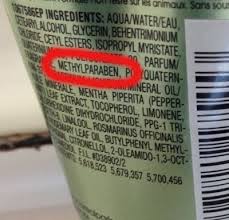|
|||||||||||||||
|

CLICK ON weeks 0 - 40 and follow along every 2 weeks of fetal development
|
||||||||||||||||||||||||||||
|
Common preservative may increase breast cancer Findings published October 27 in Environmental Health Perspectives, could have implications for the development of breast cancer and other diseases influenced by estrogens. The study also raises questions about current safety testing methods. These methods may not predict the true potency of parabens and their effects on human health. Parabens are a class of preservatives widely-used in consumer products like shampoos, cosmetics, body lotions and sunscreens. The chemicals activate the same estrogen receptor as the natural hormone estradiol. How much parabens might contribute to breast cancer risk is unclear.
Existing chemical safety tests, which measure the effects of chemicals on human cells, look only at parabens in isolation. They fail to account for parabens interaction with other types of signaling molecules that increase breast cancer risk. To better reflect real life, researchers looked at breast cancer cells expressing two types of receptors: estrogen receptors and HER2.
"While this study focused on parabens, it's also possible that the potency of other estrogen mimics have been underestimated by current testing," says co-author Chris Vulpe PhD, a toxicologist formerly with the Department of Nutritional Sciences and Toxicology, University of California, Berkeley, California, USA, who is now at the Center for Environmental and Human Toxicology at the University of Florida College of Veterinary Medicine, USA. Since people come into contact with multiple chemicals every day through consumer products — understanding how mixes of hormone-mimicing chemicals affect growth factors promoting cell growth, might better reflect a person's potential cancer exposure risk.
Abstract Objectives: We investigated the hypothesis that the potency of parabens can be increased with HER ligands, such as heregulin (HRG). Methods: The effects of HER ligands on paraben activation of c-Myc expression and cell proliferation were determined by real-time PCR, western blots, flow cytometry and chromatin immunoprecipitation assays in ERα- and HER2-positive human BT-474 breast cancer cells. Results: Butylparaben (BP) and HRG produced a synergistic increase in c-Myc mRNA and protein levels in BT-474 cells. Estrogen receptor antagonists blocked the synergistic increase in c-Myc protein levels. The combination of BP and HRG also stimulated proliferation of BT-474 cells compared to BP alone. HRG decreased the dose required for BP-mediated stimulation of c-Myc mRNA expression and cell proliferation. HRG caused the phosphorylation of serine 167 in ERα. BP and HRG produced a synergistic increase in ERα recruitment to the c-Myc gene. Conclusion: Our studies demonstrate that HER ligands enhance the potency of BP to stimulate oncogene expression and breast cancer cell proliferation in vitro via ERα, suggesting that parabens might be active at exposure levels not previously considered toxicologically relevant from studies testing their effects in isolation. Additional background: Shawn Pan, Chaoshen Yuan, Abderrahmane Tagmount, Ruthann A. Rudel, Janet M. Ackerman, Paul Yaswen, Chris D. Vulpe, and Dale C. Leitman. 2015. Parabens and Human Epidermal Growth Factor Receptor Ligands Cross-Talk in Breast Cancer Cells. Environmental Health Perspectives. Link to paper: http://ehp.niehs.nih.gov/14-09200 |
Nov 2, 2015 Fetal Timeline Maternal Timeline News News Archive Paraben free products state that they are on their list of ingredients.
|
||||||||||||||||||||||||||||



